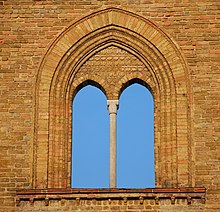Amullionis a verticalelementthat forms a division between units of a window or screen, or is used decoratively.[1]It is also often used as a division between double doors. When dividing adjacentwindowunits its primary purpose is a rigid support to the glazing of the window. Its secondary purpose is to provide structural support to an arch orlintelabove the window opening. Horizontal elements separating the head of a door from a window above are calledtransoms.

History
editStone mullions were used inArmenian,SaxonandIslamic architectureprior to the 10th century. They became a common and fashionable architectural feature across Europe inRomanesque architecture,with paired windows divided by a mullion, set beneath a single arch. The same structural form was used for open arcades as well as windows, and is found in galleries and cloisters.
InGothic architecture,windows became larger and arrangements of multiple mullions and openings were used, both for structure and ornament. This is particularly the case inGothic cathedrals and churcheswherestained glasswas set in lead and ferramenta between the stone mullions. Mullioned windows of a simpler form continued to be used into theRenaissanceand variousRevival styles.Italian windows with a single mullion, dividing the window into two equal elements are said to be biforate, or to parallel the Italianbiforewindows.[2]
Design
editMullions may be made of any material, butwoodandaluminiumare most common, although glass is also used between windows.[3]I. M. Peiusedall-glass mullionsin his design of JFK Airport's Terminal 6 (National Airlines Sundrome), unprecedented at the time.[4]
Mullions are vertical elements and are often confused withtransoms,which lie horizontally. In US parlance, the word is also confused with the "muntin"(" glazing bar "in the UK) which is the precise word for the very small strips of wood or metal that divide asashinto smaller glass "panes" or "lights".
A mullion acts as a structural member, in most applications the mullion transfers wind loads and weight of the glazing and upper levels into the structure below. In acurtain wallscreen, however, the mullions only support the weight of the transoms, glass and any opening vents. Also in the case of a curtain wall screen the weight of glazing can be supported from above (providing the structure can take the required loads) this puts the mullions under tension rather than compression.
When a very large glazed area was desired before the middle of the nineteenth century, such as in the large windows seen inGothicchurches orElizabethanpalaces, the openings necessarily required division into a framework of mullions and transoms, often of stone. It was further necessary for each glazed panel, sash orcasementto be further subdivided by muntins or leadcamesbecause large panes of glass were reserved primarily for use as mirrors, being far too costly to use for glazing windows or doors.
In traditional designs today, mullions and transoms are normally used in combination with divided-light windows and doors when glazing porches or other large areas.
See also
edit- Bifora,a mullioned window
- Mullion wall
References
edit- ^"Definition of MULLION".merriam-webster.Retrieved2017-09-20.
- ^"Biforate window".Oxford Reference.
- ^"building construction".Encyclopedia Britannica.Retrieved2017-09-20.
- ^"I.M. Pei's JFK in Terminal Trouble - Archpaper".archpaper.16 June 2010.Retrieved2017-09-20.
Further reading
edit- Müller, W.; G. Vogel (1992).Atlante di architettura.Milan: Hoepli.ISBN88-203-1977-2.
External links
edit- Media related toMullionsat Wikimedia Commons